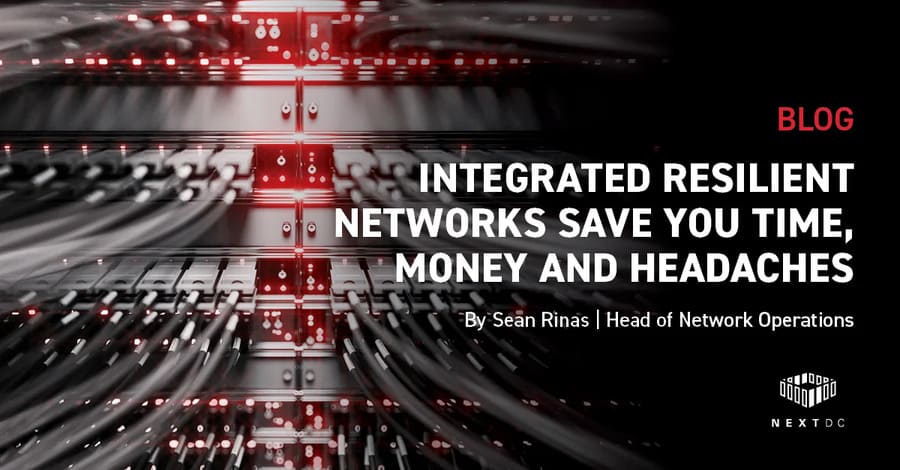As seen on Computer World
NEXTDC is a company which recognises that not everybody can simply up-sticks and move everything to the cloud. Similarly, it is never as simple as just up-and-moving the physical infrastructure that remains to a colocation facility. Through the vital learnings of its own operational experiences, as well as those of its customers, NEXTDC has formed a unique specialisation in the area of transitional Cloud migrations.
This experience in digitally transforming its own business has demonstrated that colocating critical physical infrastructure in proximity to public cloud platforms forms a crucial stage in building resilient Hybrid Cloud architectures.
Colocation is the practice of migrating critical infrastructure (or legacy equipment) to a specialist colocation data centre facility where it can run in under optimal operating conditions. It is an environment that is devoid of equipment-damaging humidity, where air conditioning and server noise doesn’t distract workers, where power and physical security costs are cheaper, where engineering and operational processes rival the best in the world, and where support technicians are on hand 24/7.
Colocation allows organisations to relinquish prime real estate required for housing IT infrastructure on premises, leaving more office space for your workers or offloading that overhead altogether.
Jeff Arndt, CIO of NEXTDC said his journey to hybrid cloud is a real-life use-case for the company’s unique value proposition. He says that despite NEXTDC openly calling itself a Cloud-first company, it knows better than anybody that some equipment and services just cannot be moved directly to the Cloud. However, it also knows that many of the benefits of a Hybrid Cloud strategy – such as moving IT infrastructure offsite, reducing costs and running OpEx rather than CapEx budgetary models – is fully achievable for most workloads.
The framework for premium Uptime certified data centres cannot be fudged, comprising top-level operational sustainability requirements and strict reliability definitions. Arndt says the challenge presented a fundamental question: “How do we take unique constraints and inhibitors in our business and adopt Cloud where it makes sense, while also keeping our legacy environment and maintaining our on-premise footprint where necessary, without inhibiting our ability to meet defined business objectives?”
The questions needed to be asked because NEXTDC originally operated as a construction-oriented data centre business. However, as customers grew and their interactions multiplied into the hundreds of thousands, it realised it needed to balance the focus of not just being a construction company, but also meet the need to provide an optimal customer experience as a market differentiator.
Arndt says, “The fastest way to do that was through Cloud applications and offerings but that will only get you so far, particularly when you have legacy technologies, operational dogma and infrastructure.”
The company realised it was using many different partners while constructing bespoke infrastructure for each customer. This created a disparate melange of operating environments that were becoming increasingly complex to manage. To create a better customer experience, the need for a unified IT blueprint that wouldstandardise services, operations and support became essential. In turn, this led to NEXTDC’s accelerated maturation as a premium colocation specialist.
It subsequently gained invaluable expertise in auditing and unravelling onsite infrastructural asset-related messes and setting them up as off-site, cost-efficient services that were power-efficient, highly convenient, fully supported and unified. Having them colocated immediately next to the clouds the company were connected to was an added bonus.
Suddenly, organisations, CIOs and CTOs, who may have had no idea how to transition to the Cloud, could create a clear roadmap that charted their journey. More importantly, NEXTDC was offered an invaluable steppingstone in colocation enroute to that end destination. It gave them the opportunity to focus on the immediate priorities of the scaling business, whilst the other components of its IT strategy were maintained and supported in the most optimal and cost effective manner.
So, when is colocation a suitable option? The prime candidates for first steps are the workloads that currently remain on-premises. Whilst you can run almost anything in the Cloud, not all workloads meet acceptable performance standards when run in a Cloud environment and moving them may not be easily justified. Additionally, it is hard to justify the business case for moving legacy equipment which has not yet reached the end of its operational lifecycle. However, if sweating the last drop of value out of legacy equipment is costing money in terms of power, maintenance and support, there are significant cost advantages of moving its functionality to a colocation facility.
For example, a NEXTDC customer captured multiple, live feeds from transport networks and made operational decisions based upon them in real time. Even the fastest remote links struggled to carry this mission critical data in such a scenario and so. To optimise application performance, equipment needed to be housed close to the base of operations. In such an instance, colocation proved to be the perfect solution as real-time data could be captured, analysed and processed instantaneously, whilst maintaining the closest possible relationship to other cloud workloads, which were directly connected within the facility.
Ultimately, any organisation with legacy infrastructure, distributed environments or those needing to bed down its disaster recovery strategy will benefit from colocation. If an organisation is looking to optimise operations and enable business strategy through a true Hybrid IT architecture, it should strongly consider colocation.
For further information about building a secure and resilient hybrid Cloud environment that shifts assets from decaying capital expenditure to Infrastructure-as-a-Service-oriented OpEx, connect with a NEXTDC colocation specialist.


